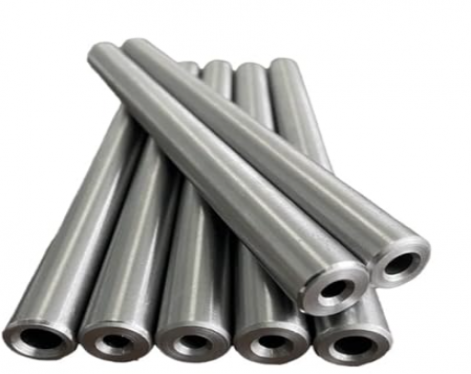Anti-corrosion treatment of precision seamless pipes is crucial because they are often used in areas with high requirements for fluid cleanliness, equipment reliability and long-term operating life, such as hydraulic systems, automotive pipelines, instrumentation, etc. Although the precision seamless pipe itself has high internal and external surface finish, if appropriate anti-corrosion measures are not taken, it may still rust due to oxidation, water vapor or medium corrosion, affecting its performance. The following carefully summarizes the five common methods of corrosion protection for precision seamless pipes
Principle: The surface of the steel pipe reacts with the phosphate solution to form a layer of water-insoluble phosphate conversion film. This film itself has a certain corrosion resistance. More importantly, it provides excellent lubrication and paint adhesion.
Features:
Common pretreatment: In the cold drawing process, phosphating is an important lubricating carrier, while in the field of corrosion protection, phosphating film is often used as a primer to provide a good adhesion basis for subsequent oiling, painting or impregnation of rust inhibitors.
Limited corrosion protection: The corrosion protection ability of phosphate coating alone is limited and usually needs to be used in conjunction with oiling or painting.
Application: Typical pre-treatment for cold-drawn precision tubes, and also an economical choice for rust prevention of general mechanical parts.
2. Anti-rust Oil/Fluid Coating
Principle: A thin layer of anti-rust oil is applied on the surface of the steel pipe or the steel pipe is immersed in anti-rust liquid to form a physical barrier to isolate air and moisture, and the corrosion inhibitors therein are used to inhibit corrosion.
Features:
Simple and Economical: This is the most commonly used and economical temporary corrosion protection measure.
Limited Protection: The protection period of rust preventative oil varies depending on the type of oil, application quality, and storage environment, typically lasting from several months to a year.
Easy to Clean: Degreasing and cleaning are generally required before use.
Application: Basic protection for steel pipes during shipment, transportation, and short-term storage.

Principle: Through electrochemical methods, a layer of other metals such as zinc, nickel, chromium, etc. is plated on the surface of the steel pipe.
Features:
Galvanizing: Economical and provides sacrificial anodic protection, but hot-dip galvanizing typically produces a thicker coating, which may affect precision dimensions. Cold-dip galvanizing, on the other hand, offers a thinner coating and limited corrosion protection.
Nickel plating: Offers excellent corrosion resistance, wear resistance, and gloss.
Chrome plating (hard chrome plating): Significantly improves surface hardness, wear resistance, corrosion resistance, and finish. This is the most common surface treatment for precision seamless pipes (especially for components such as hydraulic cylinder piston rods). The chrome plating imparts exceptional durability.
Application: Hydraulic cylinders, cylinder piston rods (chrome plating), and some mechanical parts that require wear resistance and medium corrosion resistance.
4. Internal/External Coating
Principle: A high-performance polymer coating, such as epoxy, polyurethane, or polyethylene, is sprayed or lined on the inner and outer surfaces of a steel pipe.
Features:
Excellent corrosion resistance: Provides physical barrier protection and strong chemical resistance.
Various coating types: Choose from different coatings based on the application (e.g., drinking water, chemical media).
Potential impact on precision: For extremely high-precision pipes, coating thickness must be strictly controlled, or only the outer surface may be coated.
Applications: Precision pipes used to transport fluids (particularly drinking water, gas, and chemical media) require a clean, contamination-free inner surface.
5. Stainless Steel Precision Tubes
Principle: This is not an "anti-corrosion method", but anti-corrosion is achieved from the material itself. Since stainless steel contains a large amount of alloy elements such as chromium, it can form a dense passivation film on the surface, thus having inherent corrosion resistance.
Features:
Integral corrosion protection: Provides corrosion protection from the base material, eliminating the need for additional coatings (unless specifically requested).
Higher cost: Stainless steel pipes are significantly more expensive than carbon steel pipes.
Application: Applications with extremely high requirements for corrosion resistance and fluid cleanliness (such as medical, food, semiconductor) or where additional surface treatment is not possible.
Read more: Characteristics and Uses of Precision Seamless Pipes
1. Phosphating
Principle: The surface of the steel pipe reacts with the phosphate solution to form a layer of water-insoluble phosphate conversion film. This film itself has a certain corrosion resistance. More importantly, it provides excellent lubrication and paint adhesion.
Features:
Common pretreatment: In the cold drawing process, phosphating is an important lubricating carrier, while in the field of corrosion protection, phosphating film is often used as a primer to provide a good adhesion basis for subsequent oiling, painting or impregnation of rust inhibitors.
Limited corrosion protection: The corrosion protection ability of phosphate coating alone is limited and usually needs to be used in conjunction with oiling or painting.
Application: Typical pre-treatment for cold-drawn precision tubes, and also an economical choice for rust prevention of general mechanical parts.
2. Anti-rust Oil/Fluid Coating
Principle: A thin layer of anti-rust oil is applied on the surface of the steel pipe or the steel pipe is immersed in anti-rust liquid to form a physical barrier to isolate air and moisture, and the corrosion inhibitors therein are used to inhibit corrosion.
Features:
Simple and Economical: This is the most commonly used and economical temporary corrosion protection measure.
Limited Protection: The protection period of rust preventative oil varies depending on the type of oil, application quality, and storage environment, typically lasting from several months to a year.
Easy to Clean: Degreasing and cleaning are generally required before use.
Application: Basic protection for steel pipes during shipment, transportation, and short-term storage.

3. Electroplating
Principle: Through electrochemical methods, a layer of other metals such as zinc, nickel, chromium, etc. is plated on the surface of the steel pipe.
Features:
Galvanizing: Economical and provides sacrificial anodic protection, but hot-dip galvanizing typically produces a thicker coating, which may affect precision dimensions. Cold-dip galvanizing, on the other hand, offers a thinner coating and limited corrosion protection.
Nickel plating: Offers excellent corrosion resistance, wear resistance, and gloss.
Chrome plating (hard chrome plating): Significantly improves surface hardness, wear resistance, corrosion resistance, and finish. This is the most common surface treatment for precision seamless pipes (especially for components such as hydraulic cylinder piston rods). The chrome plating imparts exceptional durability.
Application: Hydraulic cylinders, cylinder piston rods (chrome plating), and some mechanical parts that require wear resistance and medium corrosion resistance.
4. Internal/External Coating
Principle: A high-performance polymer coating, such as epoxy, polyurethane, or polyethylene, is sprayed or lined on the inner and outer surfaces of a steel pipe.
Features:
Excellent corrosion resistance: Provides physical barrier protection and strong chemical resistance.
Various coating types: Choose from different coatings based on the application (e.g., drinking water, chemical media).
Potential impact on precision: For extremely high-precision pipes, coating thickness must be strictly controlled, or only the outer surface may be coated.
Applications: Precision pipes used to transport fluids (particularly drinking water, gas, and chemical media) require a clean, contamination-free inner surface.
5. Stainless Steel Precision Tubes
Principle: This is not an "anti-corrosion method", but anti-corrosion is achieved from the material itself. Since stainless steel contains a large amount of alloy elements such as chromium, it can form a dense passivation film on the surface, thus having inherent corrosion resistance.
Features:
Integral corrosion protection: Provides corrosion protection from the base material, eliminating the need for additional coatings (unless specifically requested).
Higher cost: Stainless steel pipes are significantly more expensive than carbon steel pipes.
Application: Applications with extremely high requirements for corrosion resistance and fluid cleanliness (such as medical, food, semiconductor) or where additional surface treatment is not possible.
Read more: Characteristics and Uses of Precision Seamless Pipes









